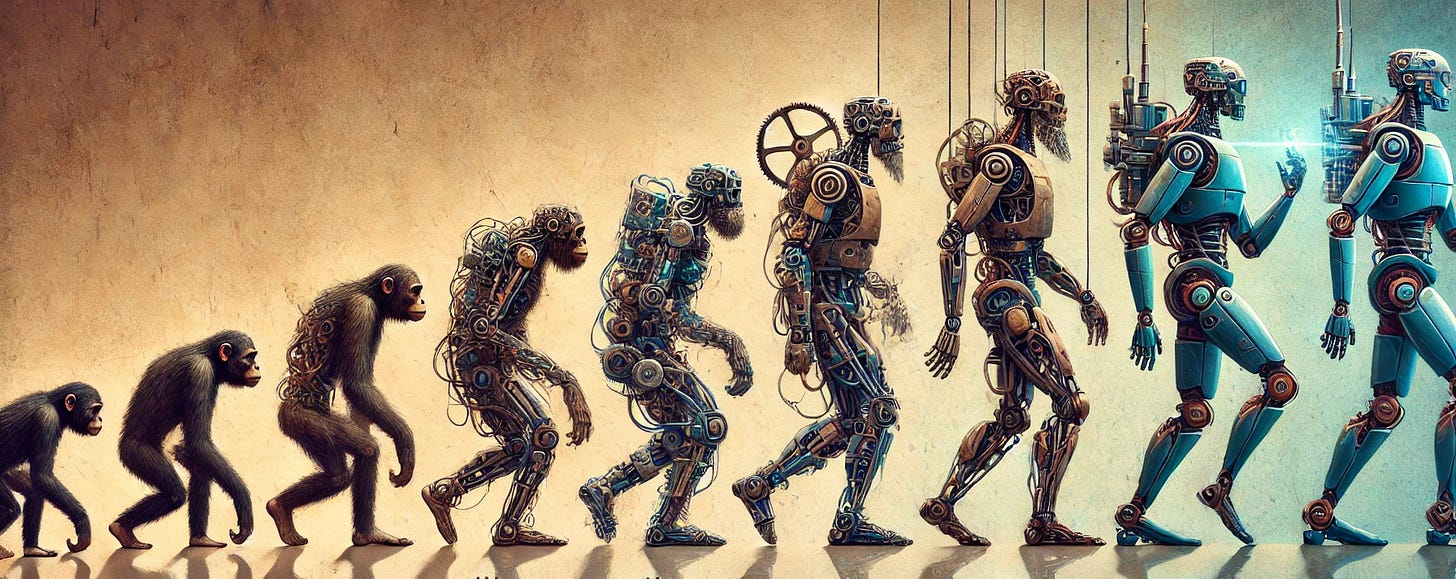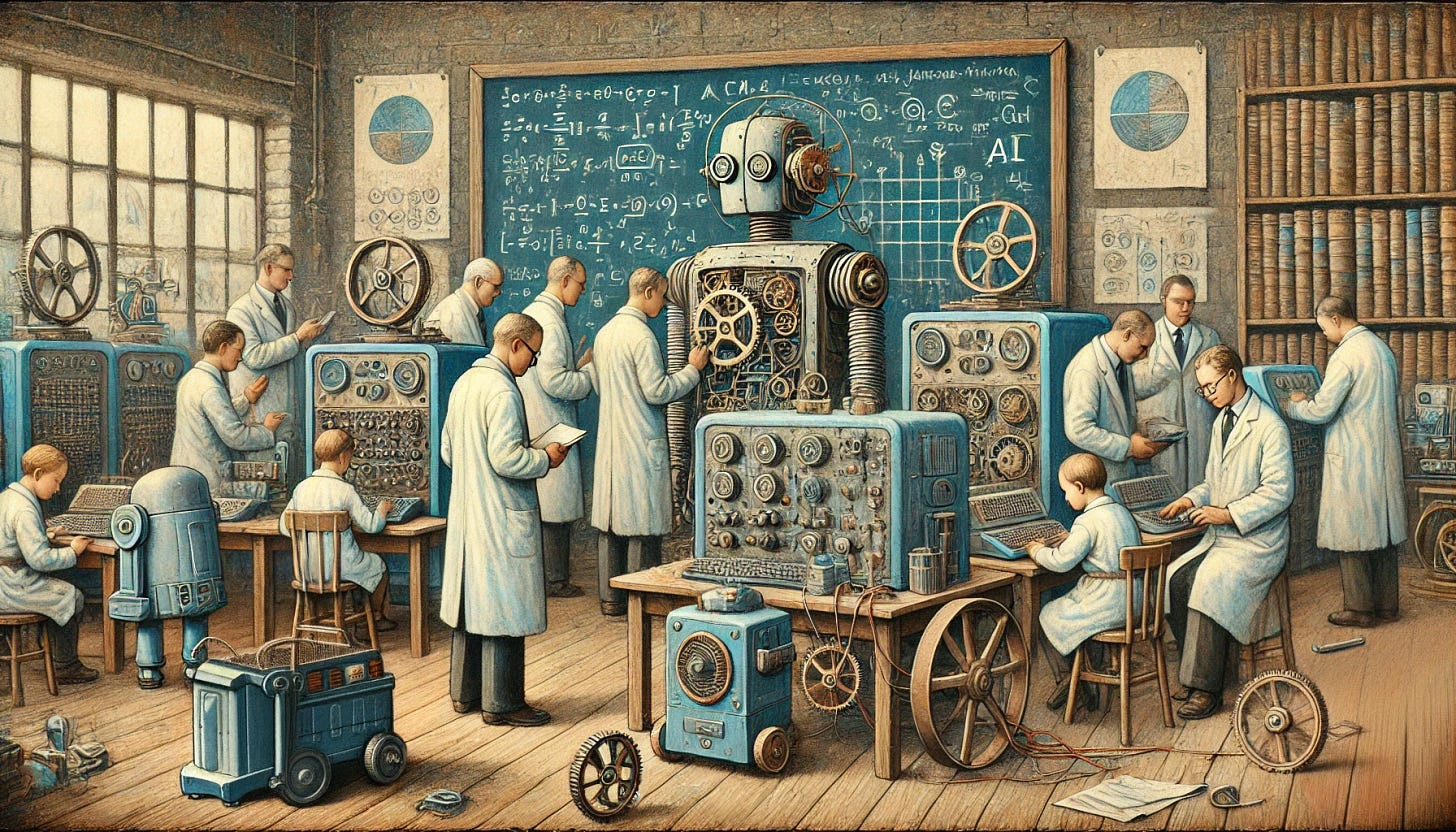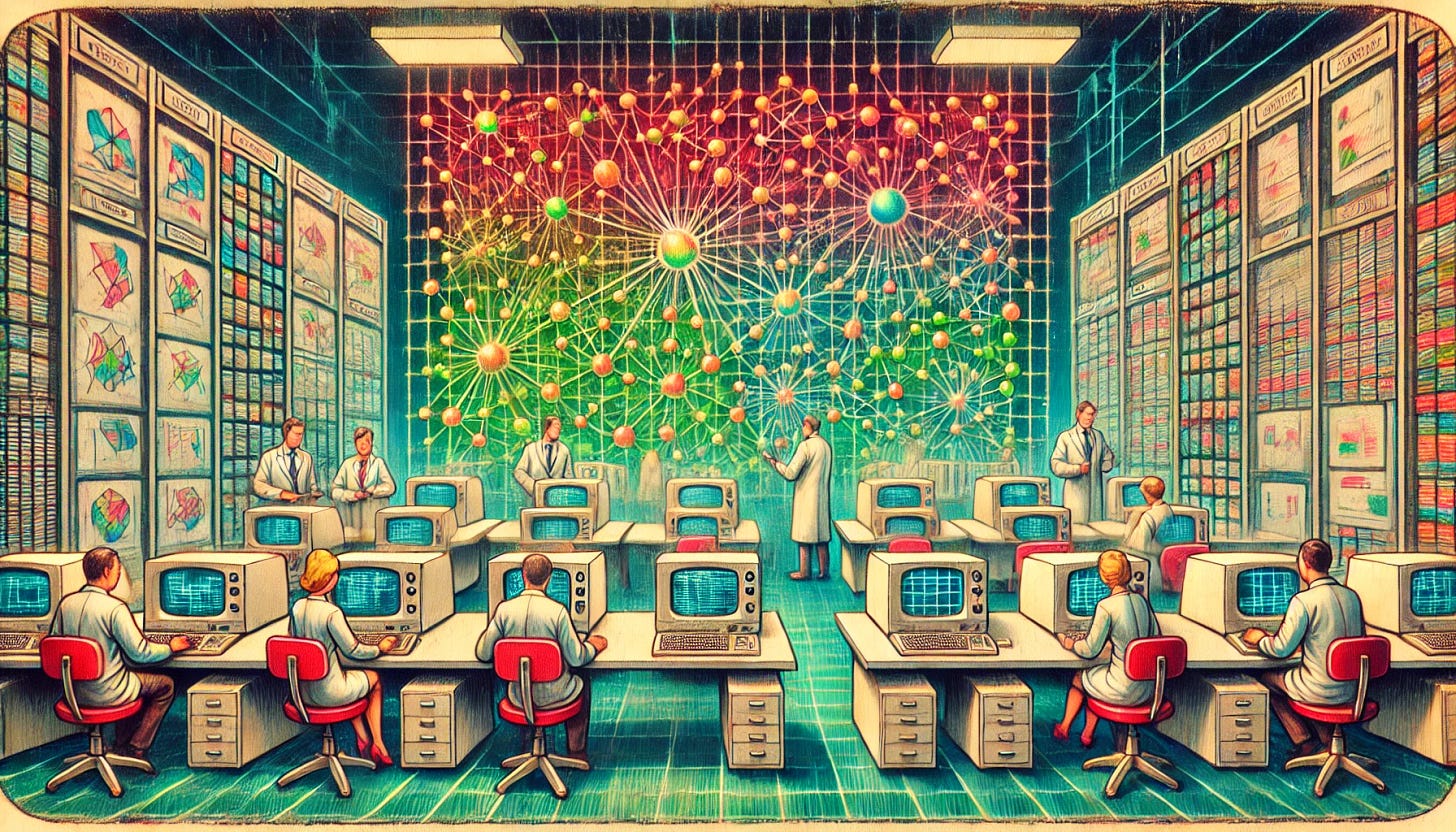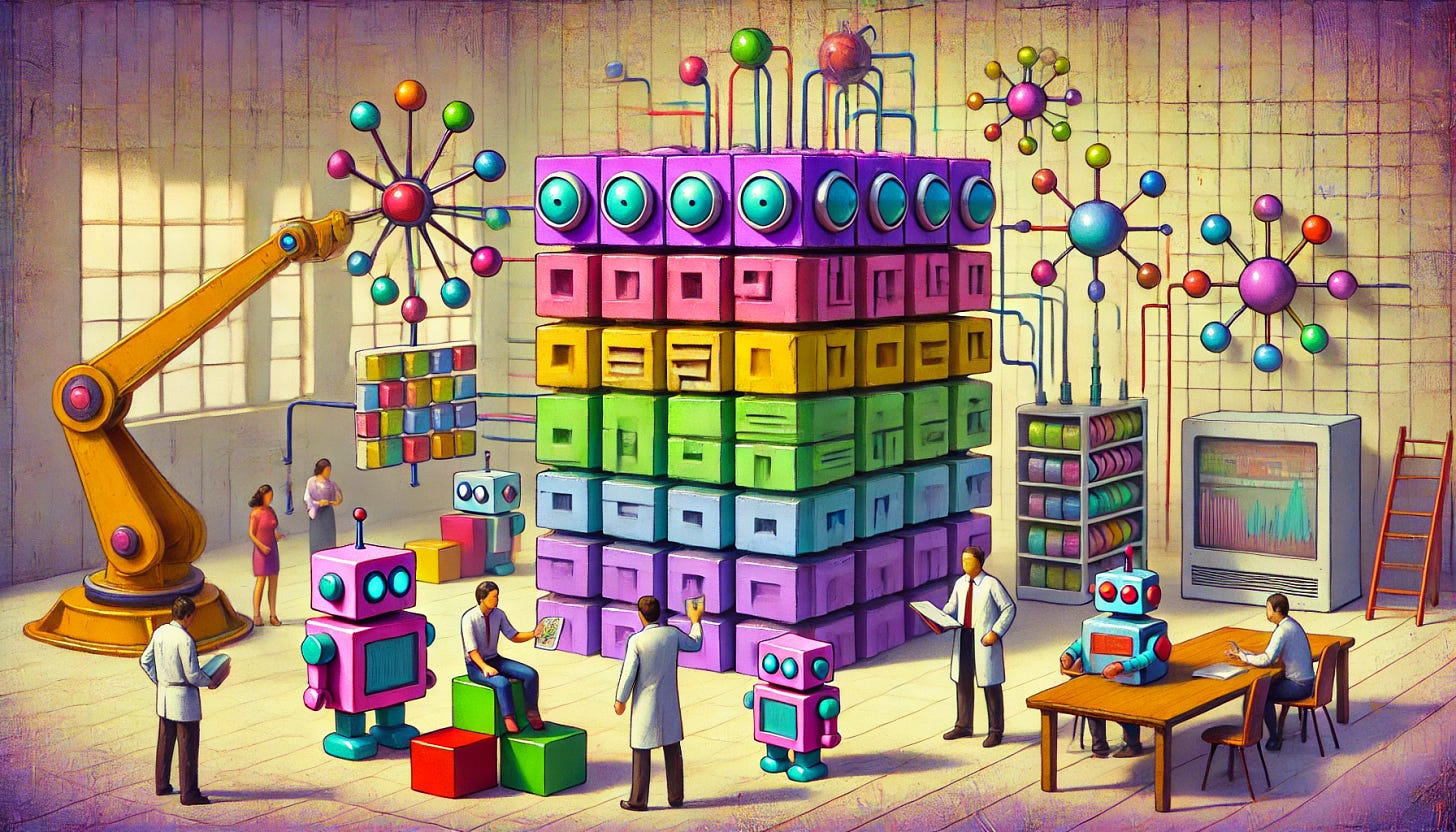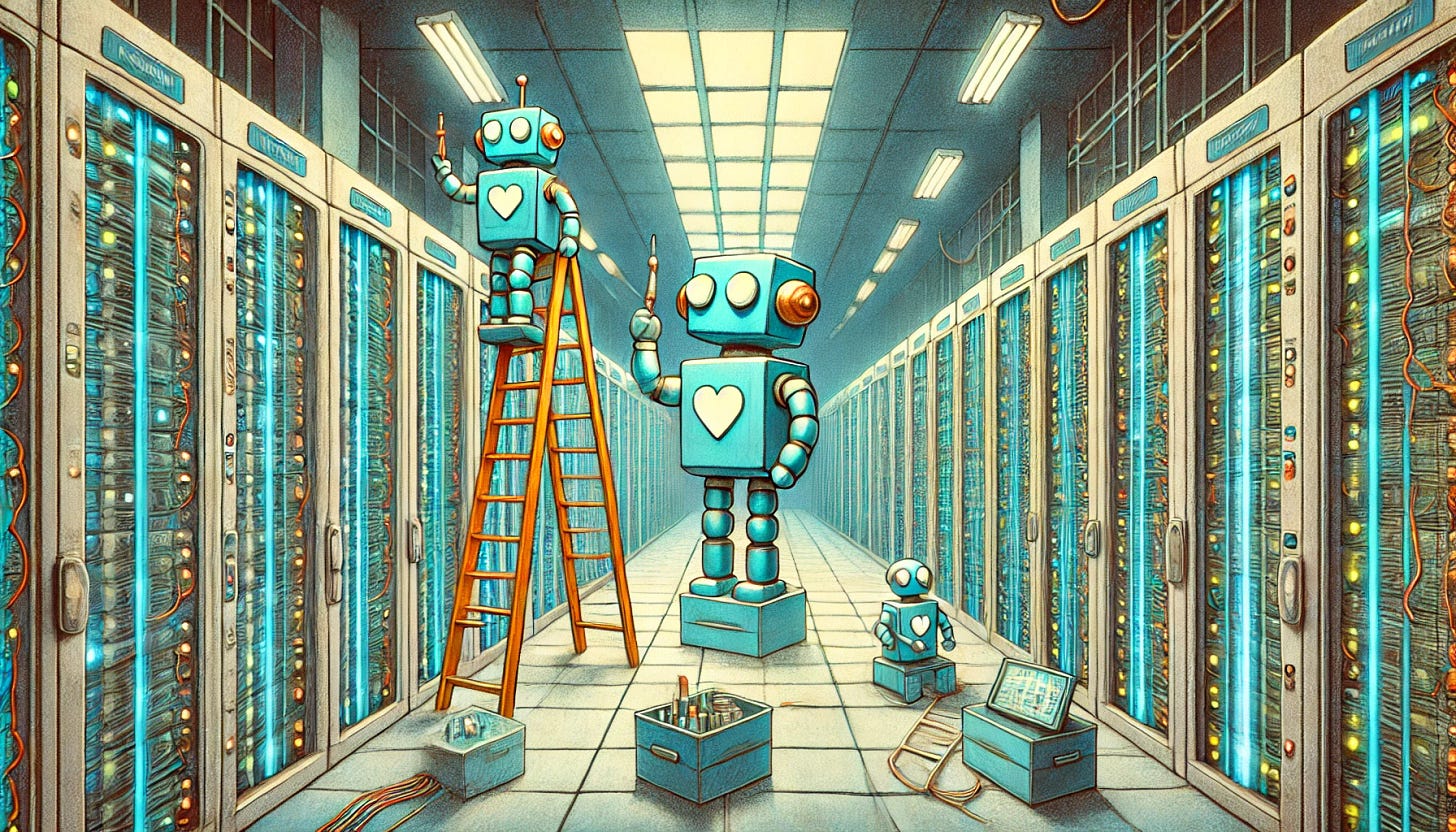When ChatGPT launched in December 2022, it reshaped the tech landscape almost overnight. OpenAI quickly rose to prominence, challenging Google's long-held AI dominance and prompting Microsoft to disrupt the search market. CEOs faced a stark reality: adapt to AI or risk irrelevance. What seemed like science fiction had become a business imperative, forcing industries to embrace a new paradigm.
However, this sudden shift was decades in the making. The current AI revolution stems from a long series of breakthroughs in research, computing power, and data science. Each innovation, from early neural models to cutting-edge architectures, built upon prior work, often without immediate recognition of its full significance.
This story is one of relentless progress—of researchers who pushed boundaries during AI’s quieter years, of hardware advancements transforming theory into application, and of separate innovations converging to create today’s capabilities. Let's explore this journey, understanding how each breakthrough shaped the AI renaissance we're now witnessing.
The Early Years (1940s-1990s)
The Birth of AI (1940s-1950s)
Warren McCulloch and Walter Pitts laid the mathematical foundations for neural networks in 1943, followed by Frank Rosenblatt's Perceptron in 1957. Neural Networks are algorithms designed to mimic how the human brain processes information. The field officially launched at the 1956 Dartmouth Workshop, where pioneers like John McCarthy, Marvin Minsky, and Claude Shannon first envisioned machines that could truly think.
The Boom-Bust Cycles (1960s-1980s)
AI experienced its first major cycle of boom and bust. Early successes with expert systems showed promise in specific domains, but limitations in processing power and data availability led to the first "AI winter." The field learned crucial lessons about the importance of domain knowledge and the challenges of replicating human reasoning.
Quiet Revolution (1980s-1990s)
While funding cooled, fundamental work continued. Yann LeCun pioneered early CNNs, Geoffrey Hinton and others refined backpropagation, and Judea Pearl developed probabilistic approaches to AI. These advances, combined with Moore's Law and growing datasets, set the stage for the deep learning revolution.
During the 1980s, Lisp-based thinking machines and expert systems experienced a surge in popularity, driven by the belief that symbolic reasoning could lead to intelligent systems. Companies like Thinking Machines Corporation and other AI ventures invested heavily in Lisp programming environments, which were seen as ideal for developing AI due to their flexibility with symbolic logic and rule-based systems.
However, the limitations of these systems, including high costs, scalability issues, and inadequate performance for real-world applications, led to disillusionment and contributed to the AI winter of the late 1980s. This period underscored the need for both better algorithms and more powerful computing infrastructure, paving the way for later breakthroughs in machine learning and neural networks.
The Foundation Years (1997-2015)
1997-2008: The Classical Machine Learning Era
Before deep learning's resurgence, machine learning was dominated by classical approaches that relied heavily on feature engineering and statistical methods. Support Vector Machines (SVMs), introduced in 1995, became the go-to method for classification tasks. Random Forests, Naive Bayes, and other ensemble methods proved powerful for structured data problems.
This era was characterized by:
Manual feature engineering as the key to success
Heavy reliance on domain expertise to design features
Limited ability to handle raw, unstructured data
Focus on supervised learning with smaller, carefully curated datasets
Unsupervised techniques like k-Nearest Neighbors for clustering and dimensionality reduction
Despite their limitations, these approaches established crucial principles that still influence modern AI:
The importance of model interpretability
Statistical rigor in evaluation
The role of domain knowledge in problem-solving
1997: Long Short-Term Memory (LSTM)
Sepp Hochreiter and Jürgen Schmidhuber introduced LSTM networks, solving a fundamental challenge in neural networks: maintaining memory over long sequences. Unlike standard RNNs, LSTMs could learn long-term dependencies without suffering from vanishing gradients.
Recurrent Neural Networks (RNNs) are a type of neural network designed to handle sequential data by maintaining a hidden state that captures information from previous inputs. Unlike regular neural networks, which treat each input independently, RNNs process sequences one element at a time, allowing them to model dependencies over time. This makes them useful for tasks like time series prediction, speech recognition, and language modeling. However, traditional RNNs often face challenges like the vanishing gradient problem, limiting their ability to learn long-term dependencies. Extensions like LSTMs and GRUs address these issues by incorporating mechanisms to better manage memory and long-term information.
While groundbreaking, LSTMs wouldn't see widespread adoption until computational resources caught up to their requirements years later. Even with modern compute, scaling up LSTMs presented significant challenges, as their memory and computational demands increased exponentially with sequence length. Numerous algorithms were developed to mitigate these limitations, but none proved fully effective at handling long-term dependencies at large scales. The Transformer architecture, introduced in 2017, was largely a response to these scaling challenges. By eliminating the need for recurrent operations and instead using self-attention mechanisms, Transformers enabled more efficient parallel processing, drastically improving scalability and performance on tasks involving long sequences.
2006: CUDA Introduction
NVIDIA’s introduction of CUDA in 2006 transformed AI research by enabling general-purpose computing on GPUs. Prior to CUDA, neural network training faced significant bottlenecks due to limited CPU processing capabilities. CUDA provided:
Parallel processing at scale, dramatically reducing training times.
A platform for faster and more efficient deep learning model development.
Early demonstrations of GPU acceleration by researchers like Andrew Ng, proving deep learning’s feasibility at scale.
This development established a foundation for modern AI infrastructure, supporting advancements in models like transformers and generative AI.
1999-2005: Computer Vision Algorithms Advance
SIFT and HOG are feature extraction techniques used in traditional computer vision before the rise of deep learning:
SIFT (Scale-Invariant Feature Transform):
Developed by David Lowe in 1999, SIFT detects and describes key points (distinctive features) in images that remain invariant under changes in scale, rotation, and even illumination. It identifies edges and corners that can be matched across different images, making it useful for tasks like image stitching and object recognition.
HOG (Histogram of Oriented Gradients):
Introduced by Navneet Dalal and Bill Triggs in 2005, HOG captures the structure and shape of objects by computing gradient directions (edge orientations) across small regions of an image. These orientations are then aggregated into histograms, enabling robust object detection. HOG was widely used in detecting pedestrians and other objects in images.
Both techniques laid the groundwork for early computer vision models but were eventually surpassed by deep learning methods like CNNs, which can learn hierarchical features directly from raw data without manual engineering.
2009: ImageNet - Computer Vision’s Catalyst
Fei-Fei Li's team revolutionized computer vision by releasing ImageNet, a massive dataset of 14 million annotated images across 20,000 categories. This wasn't just about quantity - ImageNet's rigorous labeling and diverse categories created a new standard for training data quality.
2012: AlexNet - Deep Learning's Renaissance
The ImageNet dataset proved transformative in 2012 when AlexNet, developed by Alex Krizhevsky, Ilya Sutskever, and Geoffrey Hinton, demonstrated the power of deep neural networks. Using the ImageNet dataset AlexNet achieved a top-5 error rate of just 15.3% in the ImageNet Large Scale Visual Recognition Challenge (ILSVRC), far outperforming traditional computer vision methods that relied on handcrafted features like SIFT and HOG.
The key to this success lay in the combination of several factors:
Deep Convolutional Neural Networks (CNNs): AlexNet featured multiple convolutional layers that automatically learned complex features from raw image data.
GPU Acceleration: By leveraging NVIDIA GPUs, the team significantly reduced training time, making large-scale deep learning feasible.
Dropout Regularization: The network used dropout to prevent overfitting, a major challenge in deep models.
This success shocked the computer vision community, as it demonstrated that deep neural networks, when trained on enough high-quality data, could surpass human-level performance on image classification tasks. It marked the beginning of the deep learning renaissance, shifting the focus away from manual feature engineering to data-driven feature learning and inspiring further breakthroughs in fields such as object detection, segmentation, and generative models.
The dataset proved transformative in 2012 when AlexNet demonstrated that deep neural networks, given enough quality data, could surpass human-level performance in image recognition tasks.
2013-2015: The Evolution of Word Representations
The journey to better language understanding saw several key developments:
2013: Word2Vec
Google's breakthrough in word embeddings changed how machines understand language. Word2Vec mapped words to dense vector spaces where semantic relationships became mathematical operations. Suddenly, "king - man + woman = queen" wasn't just a linguistic concept but a computable reality.
2014: FastText
Facebook AI (now Meta AI) introduced FastText, extending Word2Vec's ideas to handle subword information. This advancement was particularly valuable for morphologically rich languages and rare words, as it could generate embeddings for words not seen during training.
2015: Knowledge Distillation
Geoffrey Hinton introduced model distillation, demonstrating how to compress large, complex models into smaller, more efficient ones without significant performance loss. This concept became crucial for deploying AI in resource-constrained environments and influenced modern model optimization techniques.
Reinforced Learning and the Corporate AI Race Begins (2014-2017)
2014: DeepMind's Acquisition Signals a New Era
When Google acquired DeepMind for $500 million, it wasn't just buying a promising AI startup – it was betting on Reinforcement Learning (RL) as the path to artificial general intelligence. DeepMind's early work combining deep neural networks with RL had already produced systems that could master Atari games from raw pixels. This acquisition marked the moment when big tech recognized that RL might be the key to human-like AI capabilities.
2015: OpenAI Emerges as Competition Intensifies
The concentration of RL expertise and resources at Google sparked concern throughout the tech industry. OpenAI's formation by Elon Musk, Sam Altman, and others was a direct response – a billion-dollar commitment to ensure advanced AI development wouldn't be controlled by a single corporation. While DeepMind continued pushing the boundaries of RL under Google, OpenAI began parallel work on both RL and large language models.
2016: AlphaGo Shows RL's True Potential
DeepMind's investment in RL paid off dramatically when AlphaGo defeated Lee Sedol. This wasn't just another AI benchmark – it demonstrated that combining RL with deep neural networks could tackle problems requiring intuition and strategic thinking. The system's innovations included:
Monte Carlo Tree Search integration with deep neural networks
Monte Carlo Tree Search is a decision-making algorithm that uses random simulations to explore possible moves in complex environments, balancing exploration and exploitation to find optimal strategies.
Policy networks trained on human gameplay
Value networks refined through self-play
Self-play is a method where AI systems play games against themselves to improve without human input
Novel approaches to position evaluation
The victory validated Google's acquisition strategy and intensified the AI race. Other companies accelerated their RL research, recognizing its potential beyond games.
2017: Multiple Breakthroughs Transform RL
This year marked several crucial developments that built upon each other:
AlphaZero Redefines Self-Learning
Starting from scratch, AlphaZero mastered chess, Go, and shogi through pure self-play, surpassing all previous systems within 24 hours. This demonstrated that well-designed RL systems could exceed human knowledge without human input. Key innovations included:
Elimination of human gameplay data
Unified architecture across different games
More efficient Monte Carlo Tree Search
Novel self-play training techniques
A3C and PPO Algorithms Make RL Practical
Google's Asynchronous Advantage Actor-Critic (A3C) and OpenAI's Proximal Policy Optimization (PPO) algorithms made RL training more stable and efficient. These advances meant RL could tackle increasingly complex real-world problems.
The Impact
This period demonstrated how corporate competition could accelerate technical progress. DeepMind and OpenAI's rivalry pushed both organizations to share research while racing to achieve new breakthroughs. The success of deep RL in games led to applications in:
Robotics and control systems
Resource management
Recommendation systems
Drug discovery
Protein folding
More importantly, these years established RL as a fundamental technique for developing AI systems that could learn and improve through interaction with their environment. The principles developed for game-playing AI would later prove crucial for everything from self-driving cars to language model alignment.
The Foundation Model Revolution (2017-2020)
2017: The Transformer Architecture
"Attention is All You Need" by Vaswani et al. introduced the Transformer architecture, revolutionizing how AI processes sequential data. The paper's impact went far beyond its modest title - it eliminated the need for recurrent or convolutional neural networks in many tasks and enabled parallel processing of input sequences. This breakthrough:
Enabled more efficient training on massive datasets
Improved handling of long-range dependencies in sequences
Created a flexible architecture that scaled effectively with compute and data
The publication of "Attention is All You Need" would later prove crucial for combining RL with language models, particularly in techniques like RLHF (Reinforcement Learning from Human Feedback).
2018: The Birth of Modern Generative AI
The introduction of GPT (Generative Pre-trained Transformer) by OpenAI marked the beginning of the decoder-only architecture that would come to dominate language models. This architectural choice, championed by researchers including Ilya Sutskever, proved crucial for:
Efficient training of increasingly large models
Better handling of open-ended generation tasks
Improved transfer learning capabilities
2019-2020: Ilya Sutskever's Scale Hypothesis
Ilya Sutskever's advocacy for the "scale hypothesis" - that many AI capabilities would emerge naturally from training larger models on more data with more compute - proved prescient. His insights influenced:
The development of increasingly large language models
Investment in computational infrastructure for AI
The shift toward foundation models as a dominant paradigm
This period set the stage for the subsequent explosion in AI capabilities, leading directly to models like GPT-3, DALL-E, and eventually ChatGPT. The convergence of architectural innovations, computational scale, and novel training approaches created the foundation for AI's current renaissance.
2018: The Arrival of Contextual Embeddings
A series of breakthroughs transformed how models understand language context:
ELMo (Early 2018)
Introduced by AllenNLP, ELMo (Embeddings from Language Models) demonstrated the power of contextual word representations. Unlike static embeddings like Word2Vec, ELMo generated different representations for words based on their context. To help illustrate the significance, consider the word "bank" in these two sentences:
The fisherman sat by the bank of the river.
I need to deposit money at the bank tomorrow.
Traditional word embeddings (like Word2Vec) would treat "bank" as a single word with the same vector representation in both sentences. However, contextual embeddings generate different representations based on the word's context. In sentence 1, the embedding for "bank" would reflect a meaning related to nature (riverbank), while in sentence 2, it would reflect a financial institution.
This dynamic adaptation allows AI models to better understand and disambiguate words in complex language tasks.
BERT (Late 2018)
Google's BERT (Bidirectional Encoder Representations from Transformers) marked a fundamental shift in NLP. Building on ELMo's insights, BERT:
Introduced true bidirectional context understanding
Used masked language modeling to learn deep bidirectional representations
Enabled transfer learning for NLP tasks
Transfer learning is the process where a model trained on one task is adapted to perform other tasks with minimal additional training.
Established new state-of-the-art benchmarks across numerous language understanding tasks
BERT is pre-trained on a large corpus of text to develop contextual word embeddings, learning how language works (e.g., grammar, relationships between words, and context). This pre-training step involves tasks like predicting missing words (masked language modeling) and understanding sentence relationships.
Later, BERT can be fine-tuned on a much smaller dataset for a specific task, such as classifying customer support emails. In this case, the model might be trained to categorize emails into topics like billing issues, technical support, or product inquiries. Instead of starting from scratch, BERT leverages its pre-learned knowledge of language, requiring only minimal additional training to perform this classification task accurately.
This is a powerful example of transfer learning: pre-training builds a versatile foundation, while fine-tuning adapts the model to a specific problem with less data and training time.
The Scaling Era (2020-2023)
2020: GPT-3 Breakthrough (2020) and Scale Laws
OpenAI’s GPT-3 marked a major leap in AI capabilities. Key elements of its significance include:
A model trained with 175 billion parameters, showcasing unprecedented scale.
Use of a decoder-only transformer architecture, enabling powerful language generation.
Emergent few-shot learning capabilities, allowing the model to perform tasks with minimal examples.
Validation of the “scale hypothesis” proposed by Ilya Sutskever, which emphasized that increasing model size and data volume unlocks new capabilities.
GPT-3’s applications spanned diverse industries, influencing text summarization, creative writing, and conversational agents, and paving the way for further advancements in AI alignment and reasoning.
2021: Reinforcement Learning from Human Feedback (RLHF)
The integration of human feedback into model training marked a crucial shift. RLHF enabled models to better align with human preferences and values, leading to more useful and controllable AI systems. This technique became standard in models like ChatGPT and Claude.
2022: Mixture of Experts (MoE)
While not new, MoE architectures gained prominence as a way to scale model capacity without proportionally increasing compute requirements. By dynamically routing inputs to specialized sub-networks, MoE enabled more efficient scaling of model capabilities.
2023: GPT-4 and Advanced Reasoning
OpenAI's release of GPT-4 marked another watershed moment in AI's evolution. While ChatGPT had captured public imagination, GPT-4 demonstrated something far more profound: sophisticated reasoning capabilities that surprised even AI researchers. It could:
Tackle complex programming challenges with human-like problem decomposition
Pass professional exams at expert levels
Understand and analyze images in context
Engage in nuanced reasoning across multiple domains
Debug its own thought processes and correct mistakes
This wasn't just an incremental improvement; it represented a fundamental leap in AI's ability to understand and engage with the world. The same year saw the emergence of other specialized reasoning models, showing that AI was beginning to bridge the gap between pattern recognition and genuine problem-solving ability.
2023: Meta's Open Source Llama Disrupts the Field
Meta's release of Llama marked a watershed moment in AI democratization. By open-sourcing a state-of-the-art language model, Meta challenged the notion that advanced AI required massive corporate resources. Key implications included:
Accelerated innovation through community contributions
Enabled commercial applications without dependency on API providers
Sparked a wave of specialized model adaptations
Created new opportunities for edge deployment and local computing
The model's efficiency gains were particularly notable, achieving GPT-3 level performance with significantly fewer parameters. This breakthrough validated Meta's investment in fundamental AI research and demonstrated the power of open collaboration.
The Next Frontier (2024-)
Starting in 2024, recent breakthroughs and major announcements signal a new phase in AI's rapid evolution, with innovations poised to reshape the industry for years to come. Advances in large-scale infrastructure projects are set to secure the future of AI research and deployment on a global scale. New reasoning agents are emerging with enhanced problem-solving and automation capabilities, driving breakthroughs across industries. Additionally, open-source AI models are accelerating innovation by democratizing access to state-of-the-art technology. These developments are paving the way for more scalable, collaborative, and explainable AI systems, with far-reaching impacts on business operations, scientific discovery, and national infrastructure.
2024: Q* (Q-star) and Neural Architectures
OpenAI's o1 model, initially codenamed "Q*" and later "Strawberry," represents a significant advancement in AI reasoning capabilities. By incorporating a "think, then answer" approach, o1 enhances its performance in complex tasks such as mathematics and programming. This deliberate reasoning process allows the model to generate more accurate and thoughtful responses, marking a departure from previous models that relied more heavily on rapid, pattern-based outputs
The integration of symbolic reasoning and neural networks, highlighted by the Q* framework, aims to improve AI reliability and reasoning capabilities. Notable aspects include:
Hybridization of neural and symbolic methods to enhance explainability and verifiability.
Addressing limitations of neural networks in logical deduction and structured reasoning tasks.
Potential applications in fields requiring high explainability, such as legal analysis, scientific discovery, and complex decision-making.
By bridging data-driven learning and rule-based reasoning, Q* models represent a crucial step toward more robust AI systems.
2025: Infrastructure Meets Innovation
OpenAI's Stargate Project emerges as a transformative force in AI infrastructure. This $500 billion joint venture between OpenAI, SoftBank, Oracle, and MGX isn't just another data center project - it's America's bold move to secure its AI future. The initiative promises to:
Create hundreds of thousands of jobs
Build next-generation AI compute infrastructure
Establish new energy facilities to power AI development
Secure U.S. leadership in advanced AI capabilities
Meanwhile, two revolutionary AI agents redefine what's possible in automation and research:
Operator: The Autonomous Problem Solver
OpenAI's long anticipated Operator project introduces a new paradigm in task automation. This AI agent transforms how we approach daily operations by:
Executing practical tasks autonomously
Streamlining routine operations
Enhancing operational efficiency across business functions
Setting new standards for AI-human collaboration
Deep Research: Accelerating Discovery
Leveraging the groundbreaking O3 model, OpenAI’s Deep Research promises to revolutionize online research capabilities:
Autonomous information synthesis across multiple sources
Generation of comprehensive reports in minutes
Deep analysis for fields ranging from finance to engineering
Integration of diverse data sources for holistic insights
2025: DeepSeek R1 Challenges the Status Quo
January 2025 saw DeepSeek, a Chinese AI pioneer, release the R1 model - a development that forces us to rethink the economics of AI advancement. The open-source model demonstrates:
Comparable performance to leading proprietary models
Significantly reduced resource requirements
New possibilities for accessible AI development
A challenge to traditional AI investment paradigms
The convergence of these developments - massive infrastructure investment, autonomous agents, and efficient open-source models - signals a fundamental shift in how we build, deploy, and interact with AI systems. We're witnessing the emergence of an AI ecosystem where computational power, autonomous capabilities, and accessible innovation create new possibilities for human-AI collaboration.
Looking Forward
The journey of AI is shaped by cycles of progress and reflection. Each stage has built on past advancements, forming a foundation for future growth.
Early neural networks informed today’s deep learning systems.
Expert systems underscored the importance of domain knowledge.
Hardware limitations prompted innovations in computational efficiency.
Failures exposed gaps in research, refining our understanding of AI's potential.
Key papers, including McCulloch and Pitts’ work on neural networks and Vaswani’s “Attention is All You Need,” have guided advancements. These works illustrate how innovation often depends on combining developments across algorithms, hardware, and practical applications.
Looking forward, the core questions of AI research remain:
How can machines learn, reason, and adapt?
How will new developments in infrastructure, autonomous agents, and open-source models drive progress?
AI is moving toward becoming a more integral part of discovery and problem-solving, requiring an ongoing balance between technical achievement and real-world relevance.





